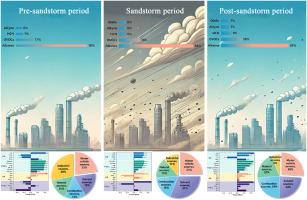从输入到转化:沙尘暴中挥发性有机化合物的动态演变及其驱动机制研究
IF 7.3
2区 环境科学与生态学
Q1 ENVIRONMENTAL SCIENCES
引用次数: 0
摘要
沙尘暴是干旱半干旱地区频繁发生的自然现象,对空气质量和生态系统产生重大影响。在沙尘暴天气中,挥发性有机化合物(VOCs)表现出较高的光化学反应性和形成二次污染物的强烈倾向。然而,控制它们与尘埃颗粒相互作用的机制仍然知之甚少。本研究在宁夏银川市城市生态系统定位站进行同步观测,收集了不同沙尘暴阶段的气象参数、大气污染物和VOCs数据。采用正矩阵分解和结构方程模型相结合的方法,系统分析了沙尘暴过程中VOCs、污染源的动态演变及其驱动机制。结果表明:沙尘期间,总VOCs浓度由沙尘前期的36.14 × 10-9下降至20.76 × 10-9,沙尘后期逐渐上升至23.58 × 10-9;挥发性有机化合物的主要来源包括烷烃和含氧挥发性有机化合物。沙尘暴的输入改变了VOCs组分的比例,其中低反应性烷烃的减少最为明显。在沙尘暴前期,VOCs主要来源于工业活动和机动车排放,贡献率分别为28%和23%。在沙尘暴和沙尘暴后,溶剂源和机动车排放成为VOCs的主要来源。在沙尘暴后期,风速等气象因子对VOCs的稀释作用最大,而温度和湿度对VOCs的产生有促进作用。沙尘暴期间,沙尘颗粒主要对VOCs浓度产生稀释作用,而沙尘暴后,沙尘颗粒通过促进二次污染物的形成,对VOCs浓度的升高起促进作用。该研究增强了对沙尘暴复合污染形成的理论认识,为区域污染控制策略提供了科学指导。本文章由计算机程序翻译,如有差异,请以英文原文为准。


From input to transformation: Investigating the dynamic evolution of volatile organic compounds and driving mechanisms during sandstorms
Sandstorms are frequent natural phenomena in arid and semi-arid regions, with significant impacts on air quality and ecological systems. Volatile organic compounds (VOCs) demonstrate high photochemical reactivity and a strong tendency to form secondary pollutants during sandstorm events. However, the mechanisms governing their interactions with dust particles remain poorly understood. This study was conducted using synchronous observations at the Yinchuan Urban Ecosystem Positioning Station in Ningxia, where data on meteorological parameters, atmospheric pollutants, and VOCs were collected across different dust storm stages. By integrating Positive Matrix Factorization and Structural Equation Model, we systematically examined the dynamic evolution of VOCs, pollution sources, and their driving mechanisms during dust storm events. Results showed that during sandstorm period, the total VOCs concentration declined from 36.14 × 10−9 (pre-sandstorm period) to 20.76 × 10−9, then gradually increased to 23.58 × 10−9 (post-sandstorm period). The primary contributors to VOCs included alkanes and oxygenated VOCs. Sandstorm inputs altered the VOCs component ratios, with the most pronounced reduction observed in low-reactivity alkanes. In the pre-sandstorm period, VOCs primarily originated from industrial activities and motor vehicle emissions, contributing 28 % and 23 %, respectively. During the sandstorm and post-sandstorm period, solvent sources and motor vehicle emissions emerged as the primary sources of VOCs. Meteorological factors, such as wind speed, primarily exerted a dilution effect on VOCs, whereas temperature and humidity promoted VOCs generation in the post-sandstorm period. During the sandstorm period, dust particles mainly diluted VOCs concentrations, whereas in the post-sandstorm period, they contributed to increased VOCs levels by facilitating secondary pollutant formation. This study enhances the theoretical understanding of compound pollution formation during sandstorm events and provides scientific guidance for regional pollution control strategies.
求助全文
通过发布文献求助,成功后即可免费获取论文全文。
去求助
来源期刊

Environmental Pollution
环境科学-环境科学
CiteScore
16.00
自引率
6.70%
发文量
2082
审稿时长
2.9 months
期刊介绍:
Environmental Pollution is an international peer-reviewed journal that publishes high-quality research papers and review articles covering all aspects of environmental pollution and its impacts on ecosystems and human health.
Subject areas include, but are not limited to:
• Sources and occurrences of pollutants that are clearly defined and measured in environmental compartments, food and food-related items, and human bodies;
• Interlinks between contaminant exposure and biological, ecological, and human health effects, including those of climate change;
• Contaminants of emerging concerns (including but not limited to antibiotic resistant microorganisms or genes, microplastics/nanoplastics, electronic wastes, light, and noise) and/or their biological, ecological, or human health effects;
• Laboratory and field studies on the remediation/mitigation of environmental pollution via new techniques and with clear links to biological, ecological, or human health effects;
• Modeling of pollution processes, patterns, or trends that is of clear environmental and/or human health interest;
• New techniques that measure and examine environmental occurrences, transport, behavior, and effects of pollutants within the environment or the laboratory, provided that they can be clearly used to address problems within regional or global environmental compartments.
 求助内容:
求助内容: 应助结果提醒方式:
应助结果提醒方式:


